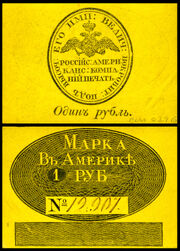| Alaskan yefimok | |
|---|---|
| Аляскинский ефимок (Russian) | |
 25 Yefimok Banknote | |
| ISO 4217 code | AKY |
| Central bank | Federal Reserve Bank of Alaska |
| User(s) | |
| Subunit | |
| 1/100 | sotka (сотка) |
| Symbol | ƒ (present) еф. (archaic) |
| sotka (сотка) | ¢ |
| Nickname | kozha |
| Coins | |
| Freq. used | 5¢, 10¢, 25¢, 50¢, ƒ1 |
| Rarely used | 1¢ (discontinued) |
| Banknotes | |
| Freq. used | 5ƒ, 25ƒ, 50ƒ, 100ƒ |
| Rarely used | 250ƒ, 500ƒ |
| Printer | Expedition of Storing State Papers |
| Website | ezgb.ak |
| Mint | New Archangel Mint and Ross Mint |
The yefimok (Russian: ефимок; pl. ефимки, yefimki; sign: ƒ; code: AKY) is the official currency of Alaska. The currency is subdivided into 100 sotkas (сотка, sotka; pl. сотки, sotki). The Federal Reserve Bank of Alaska (colloquially known as Ferebank) is the central bank and issuing authority of the Alaskan yefimok.
Etymology
The word yefimok originates from the "Joachimsthaler," which were a series of silver coins made in the town of Joachimsthal in modern day Czechoslovakia. These coins would form the basis for many currencies across the world today, including the dollar (which originates from the "thaler" portion of the name Joachimsthaler).
With their introduction into the Russian Empire in the 1650s, the Russians used the first part of the name (Joachim) instead of the second part (thaler). All-in-all, the name yefimok roughly translates as "Little Yefim," from the Russian-equivalent to Joachim (Yefim) and the suffix -ok (turning the noun into a diminutive).
The word sotka is an archaic word which used to refer to one hundredth of a measurement. For all intense and purposes, its meant to be a calque of English cent, Spanish centavo, and Bulgarian stotinka. The word has since become archaic in the Russian language today.
Symbol

Yefimok Symbol.
The symbol of the Alaskan yefimok is a variation of the Florin sign (ƒ), which appears as a stylized "F" and "J" character. The origins of this are coincidental and unrelated to the use of the symbol in Europe. It is believed that the modern symbol came about from the abbreviation еф. (yef.), with both letters gradually merging into the modern symbol.
The sotka commonly uses a variation of the cent symbol (¢), which is simply a "C" (or a Cyrillic "С") with a stroke. This symbol is also emerged coincidentally.
In the Russian language, the yefimok symbol is always placed at the end of an amount, with no or little space separating them (e.g., 29.99ƒ).
History
Russian Colonization

1 ruble scrip issued by the RAC.
The early period of Russian America was dominated by several currencies and other means of trade. This was due to the Russian ruble being rare in the territories, due to a low and isolated populace.
It was because of this that the Russian-American Company issued parchments which would be equated to rubles. These parchments could only be redeemed at company-owned general stores and were often the primary means of payment for those under the employment of the RAC (particularly fur traders). While initially printed on thick card stocks, they were later printed on sealskin and walrus skin. It was from this that the modern nickname kozha (lit. "skin") came into use in Alaska.
As population and trade began to increase by the 1830s, foreign currencies were increasingly used. These included the British pound, the Mexican peso, and the United States dollar. The dollar and peso (especially) became alternate means of payment in Oregon and Sonoma, with both currencies colloquially being referred to as yefimoks (a Russian equivalent to dollars and pesos).
With the discovery of gold in 1849, population and trade in Russian America would increase to the point that the Russian Empire needed to step in. A mint is opened in Ross to handle the influx of gold and to supply the colonies with rubles. Over time, the use of RAC scrips and foreign currencies would stop. In 1856, the British would introduce a colonial currency for Columbia, which would continue to be used until the Columbia Sale. A second mint was opened in New Archangel in the early 1900s as a consequence of the Klondike Gold Rush.
| |||||||||||||||||||||||

